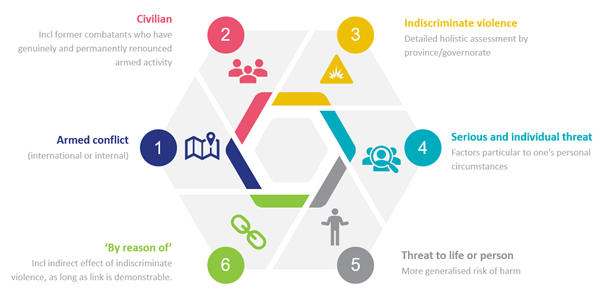COMMON ANALYSIS
Last updated: June 2022
Reference period
The following assessment is based on the EUAA COI report on the security situation in Somalia (September2021) [Security 2021]. The general reference period for this chapter is 1 January 2020 – 30 June 2021.

This guidance should be considered valid as long as current events and developments fall within the trends and patterns of violence observed within the reference period of the mentioned COI report. New events and developments that cause substantial changes, new trends or geographical shifts in the violence, may lead to a different assessment. The security situation of a given territory should always be assessed in light of the most up-to-date available COI.
Legal framework
Article 15(c) QD defines the third type of harm that constitutes a ground for qualification for subsidiary protection. It covers a more general risk of harm and the protection needs which may arise from armed conflict situations.

Under Article 15(c) QD, serious harm consists of serious and individual threat to a civilian’s life or person by reason of indiscriminate violence in situations of international or internal armed conflict.

In addition to the applicable EU legal instruments, this analysis builds on the most relevant European case law. Three judgments of the CJEU[15] and one judgment of the ECtHR have been taken into account in particular:
| CJEU, Diakité judgment [16] | The judgment is of particular importance for the interpretation of relevant concepts, and in particular of ‘internal armed conflict’. |
| CJEU, Elgafaji judgment [17] | The judgment is of importance with regard to the appreciation of the degree of indiscriminate violence and in particular with regard to the application of the ‘sliding scale’. In this judgment, the CJEU further discusses the ‘serious harm’ under the provision of Article 15(c) QD in comparison to the other grounds for granting subsidiary protection and considers the relation between Article 15(c) QD and the ECHR, in particular Article 3 ECHR. |
| CJEU, CF and DN judgment [18] | The judgment is of particular importance for the interpretation of the concept of ‘serious and individual threat to a civilian’s life or person’ in the context of an international or internal armed conflict under Article 15(c) QD. The CJEU found that ‘Article 15(c) of Directive 2011/95 must be interpreted as meaning that, in order to determine whether there is a ‘serious and individual threat’, within the meaning of that provision, a comprehensive appraisal of all the circumstances of the individual case, in particular those which characterise the situation of the applicant’s country of origin, is required.’
Furthermore, that ‘the elements to be taken into account in assessing whether there is a real risk of serious harm, within the meaning of Article 15(c) of Directive 2011/95 may also include the intensity of the armed confrontations, the level of organisation of the armed forces involved, and the duration of the conflict […], as well as other elements such as the geographical scope of the situation of indiscriminate violence, the actual destination of the applicant in the event that he or she is returned to the relevant country or region and potentially intentional attacks against civilians carried out by the parties to the conflict.’ |
| ECtHR, Sufi and Elmi judgment [19] | It should be noted that ECtHR jurisprudence on Article 3 ECHR is not of direct applicability when discussing the scope and elements of Article 15(c) QD. However, the elements outlined in Sufi and Elmi with regard to the assessment of the security situation in a country, and the degree of generalized violence, were consulted in order to design the indicators of indiscriminate violence for the purposes of this common analysis. |
Figure 11. Elements of the legal provision of Article 15(c) QD.

All of these elements have to be fulfilled in order to grant subsidiary protection under Article 15(c) QD.
Common analysis of the factual preconditions and guidance on the possible application of Article 15(c) QD with regard to the situation in Somalia is provided in the following sections.
[15] It can be noted that a relevant case is currently pending at the CJEU: Case C-579/20 (Request for a preliminary ruling from Staatssecretaris van Justitie en Veiligheid, the Netherlands) concerns the application of Article 15(c) QD when the level of ‘mere presence’ is not reached and the application of a ‘sliding scale’.
[16] CJEU, Aboubacar Diakité v Commissaire général aux réfugiés et aux apatrides, C-285/12, judgment of 30 January 2014 (Diakité).
[17] CJEU, Elgafaji v Staatssecretaris van Justitie, C-465/07, Grand Chamber, judgment of 17 February 2009 (Elgafaji).
[18] CJEU, CF and DN v Bundesrepublik Deutschland, C-901/19, Third Chamber, judgment of 10 June 2021 (CF and DN).
[19] ECtHR, Sufi and Elmi v United Kingdom, Applications nos. 8319/07 and 11449/07, judgment of 28 June 2011 (Sufi and Elmi).
